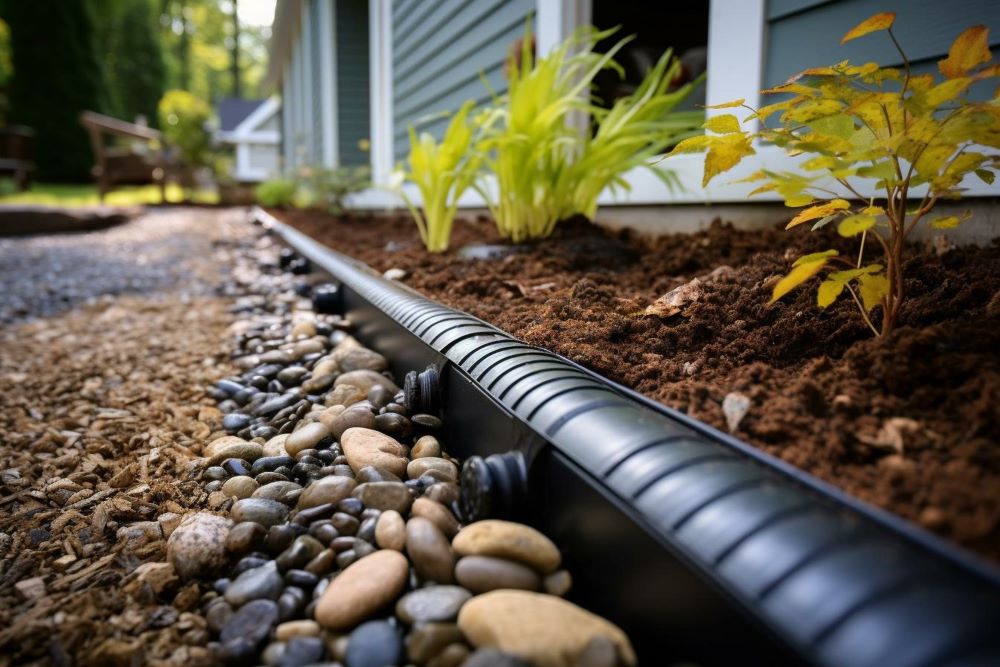
A French drain protects your basement by draining water away from the foundation walls and footings. This type of drainage system prevents moisture from accumulating and helps maintain a building’s structural integrity.
Wondering exactly how a French drain works and why installing one can help avoid water infiltration problems? Our Montreal French drain installation experts are here to explain.
What is a French drain?
Just like any other drainage system, a French drain is there to maintain the structural integrity of your building. It also offers a number of other advantages:
- Protects against moisture: A French drain prevents rainwater and melting snow from accumulating around foundation walls and footings.
- Prevents water infiltration: It also drains water to the storm sewers to prevent infiltration into your basement.
- Durable: French drains have a lifespan of around 30 years, if you check them regularly to make sure they are functioning properly.
- Easy to install: A French drain relies on gravity and gravel for easy drainage.
- Adaptable: Can be installed around or underneath a building, as needed.
Types of French drains
There are two types of French drains:
Exterior French Drain (Curtain Drain)
Exterior French drains are installed around building foundations and covered with gravel. This type of drainage system collects water before it reaches the foundation and directs it away from the structure to prevent moisture infiltration.
Installing an exterior drain demands careful excavation construction to avoid damaging pipes and other existing infrastructure. This type of drain is often considered the most effective solution for preserving building foundations over the long term.
Interior French Drain (Basement French Drain)
Interior French drains are installed within the foundations, in the basement. A 4″ pipe is laid under the concrete slab and connected to a pumping system to evacuate the water.
A drainage membrane is placed at wall level so the water flows to the drainage system. This type of drain can leave your basement damp and increases the risk of mold.
How to install a French drain
Proper preparation is key when installing a French drain. It’s the only way to be sure that your drain will effectively protect your home’s foundations.
The first step is to figure out which area is exposed to the most groundwater. A site audit carried out by a specialist can help at this stage. You’ll also need to locate any wastewater or sewage pipes to avoid causing damage during excavation, which will likely involve consulting the building plans available at your local town hall.
You’ll also need to create a drainage network for the captured water. The circuit has to be designed with a slight slope, so the water will flow naturally to a sump pump.
Now it’s time to install the French drain: dig a trench around the building. Install a perforated pipe with the holes facing downwards. Cover the pipe and fill the trench with sand and gravel. Once installation is complete, you can replant the lawn or do any necessary landscaping.
Factors influencing French drain efficiency
A French drain will be more or less effective according to 3 main factors:
- Proper installation will safeguard your building foundation. If your French drain is not installed correctly, for example if you do not put enough crushed stone in the trench or use the wrong type of materials, it can lead to substantial water runoff. A perforated pipe surrounded by at least 12 inches of crushed stone and covered with a geotextile membrane, will filter soil particles and prevent blockages.
- It’s important to inspect your drainage system regularly to detect any signs of deterioration or blockage. A camera test can reveal if the pipe is crushed or twisted, or if it is at the wrong angle. Buildings surrounded by sandy soils or dense vegetation can also affect the longevity of your French drain.
- The local environment can also have an impact. In areas with high levels of iron ochre, ferrous particles can clog the drain. You may need to do regular chimney cleaning to address the problem.
How to maintain a French drain
Proper French drain maintenance helps prevent flooding, blockages and costly damage such as foundation cracks.
An annual inspection, particularly after winter, is advisable. This process helps detect any blockages caused by debris, roots, or sediment buildup (ochre). If a blockage is found, there are several ways to clear it.
Unclogging using high pressure involves sending a high-intensity jet of water through the drain. Alternatively, a mixture of baking soda and vinegar can be used to treat less severe blockages.
If these techniques fail, it might be time to call in a professional for a thorough inspection and cleaning. Our experts are here to assist you, before, during and after the installation of your French drain.